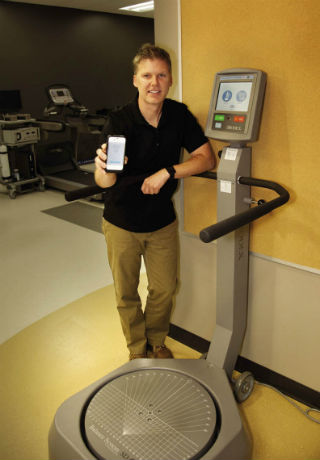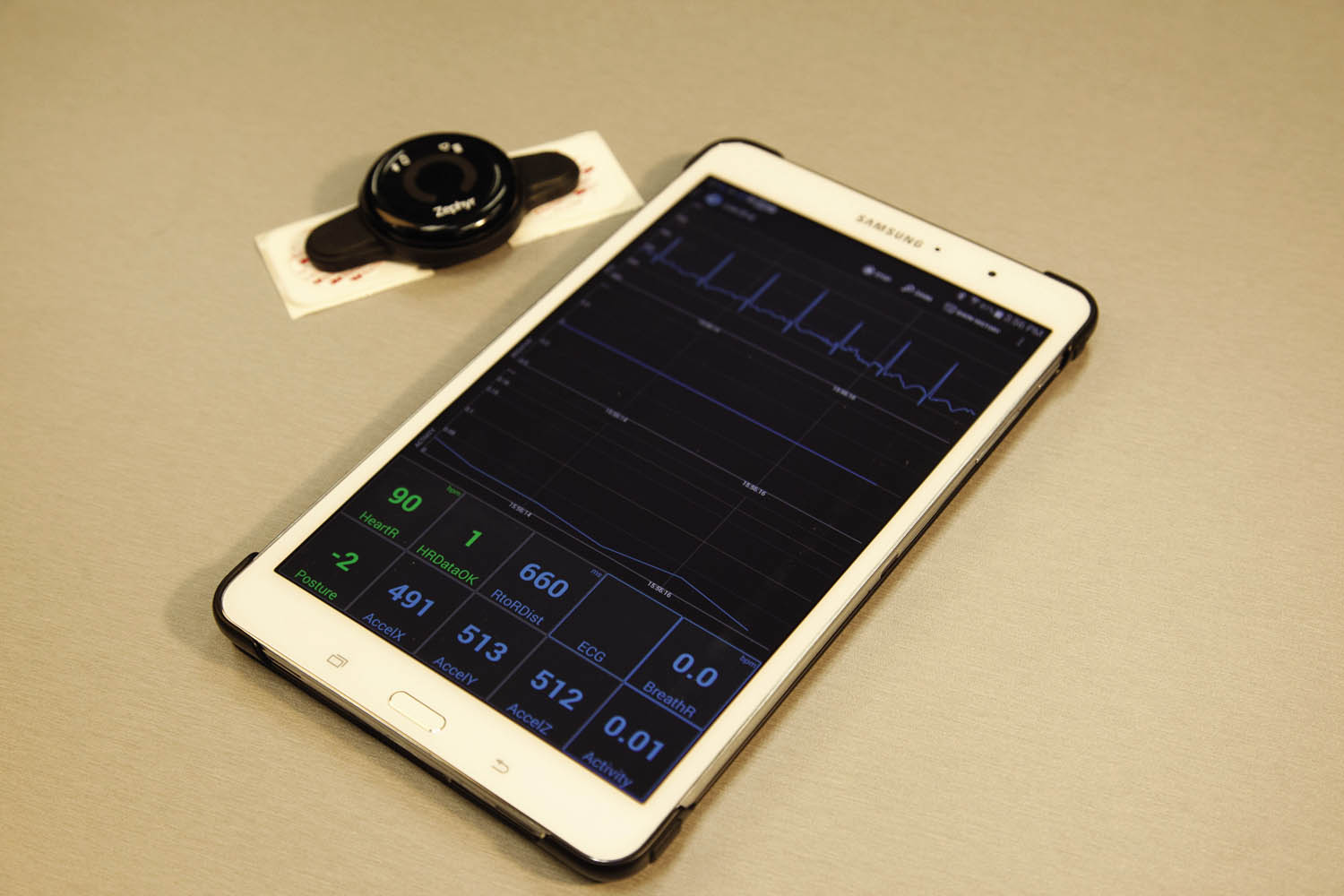 Within WSU's Department of Human Performance Studies, there are programs in athletic training, physical education and exercise science.
Within WSU's Department of Human Performance Studies, there are programs in athletic training, physical education and exercise science.
"Collectively, these programs address physical activity across the lifespan in a variety of populations ranging from school children to elite athletes to older adults," explains Michael Rogers, professor and chair of the department. "We evaluate performance in our state-of-the-art Human Performance Laboratory, develop programs to improve performance, and implement programs in the local community and beyond."
Housed in the Heskett Center, the Human Performance Lab – a high-tech exercise and testing center that doubles as a classroom – is run by associate professor Jeremy Patterson, pictured at left, who came to Wichita State in 2004. These days, Patterson is getting fewer questions from prospective students and their parents about what one can do with a degree in exercise science, which grew out of the physical education program.
"When I started, there were maybe two students in the program," he says. "Now, there are about 50 graduate students and 170 undergraduates."
Exercise science graduates are able to find work involving exercise physiology, physical therapy and rehabilitation, to name a few of their career options.
Even before they enter the workforce, Patterson believes each student is capable of contributing something unique to the field of exercise science. "Each person should be able to fill a niche, which helps us diversify," he says, adding that instead of limiting students to study and research projects that fall within faculty members' areas of expertise, he likes to see faculty share their own knowledge while at the same time nurture students' own specific interests. "Basically, we give the keys to the students and do what they want to do," he says. "It's really hard, but this system works."
This approach necessitates learning both from textbooks and from hands-on experiences in the lab, and has given birth to a healthy entrepreneurial spirit – with real dollars-and-cents results. "The students are required to do business proposals and take business classes," says Patterson. "It's like walking into the real world – find problems and figure out how to solve them."
Rogers reports, "We have been instrumental in developing over 20 new small businesses that have been started by our students." One of those businesses is Sway Medical, started in 2010 by Chase Curtiss '08, who earned a bachelor's degree from the University of Puget Sound in 2006 and then a master's degree in exercise science from Wichita State. His Tulsa, Okla.-based company offers a portable balance testing system for health care providers. "One of the things they do so well, Dr. Patterson in particular, is the concept of innovative thinking," Curtiss says of the department. "The underlying current of innovation really helped spark my career."
One of those main eddies in the lab's underlying current of innovation is an ongoing quest to re-envision big, bulky medical testing equipment into small and easy-to-use devices. It was as a grad student working in the lab on balance tests that Curtiss' innovative idea for his future business sparked to life. After much work and more research, his initial concept was transformed into the Sway Balance app.
Developed by Curtiss and tested in the lab, Sway Balance has effectively shrunk the equipment needed to perform a balance test from an approximately $15,000 scale-like machine to this app that comes at a fraction of the machine's price. Sway Balance, a U.S. Food and Drug Administration-cleared mobile balance test, allows health care professionals to quickly assess a patient's stability.
"It was something new to me, but I learned how to do everything that needed to be done," Curtiss says of meeting the FDA's guidelines.
"All the research that had to be done was done in this lab," adds Patterson. "That consumed about 18 months."
One area in which this stability-testing app is particularly helpful is concussion assessment. Patterson says traditional concussion tests only measure cognitive ability. "They aren't going to have you do activities to see if you have symptoms while doing them," he says of the tests. Curtiss and his app have provided an alternative option. Sway Balance can perform assessments while the person being tested is moving around instead of standing still.
As concussions continue to be a hot topic in professional, college and youth sports, Sway Balance is helping health care providers figure out when an athlete is ready to return to competition. In addition to Shocker student-athletes, students at Wichita public high schools are tested with the app. First, an athlete is given an initial test to determine his or her baseline score. In the event of an injury, the athlete is tested again and measured against the original score. "We've been measuring student-athletes in town for a few years," says Patterson. "We're tracking concussion management for high schoolers."
Along with concussion-related testing, Sway Balance can be used to help assess fall risk and physical therapy progress.
As Patterson continues his balance assessments and other research projects, two things are key: innovation and collaboration – collaboration with internal university partners as well as outside entities. "The research conducted by Human Performance Studies covers a wide range of topics, including strength training, aerobic performance, balance assessment, body composition, bone health and more," says Rogers. "We have performed a large number of studies with colleagues in Japan, New Zealand, Spain, Denmark, Canada and Korea, and some of the programs that we have developed, particularly the activity programs for older adults, have been evaluated and adopted by these other countries."
Within the department, Rogers, Patterson and Kaelin Young, assistant professor of exercise science, share the Human Performance Lab. "That's unusual," Patterson says of the shared space. "It only works because we work really well together."
This research diversity – and collaboration – means those who work within the department have opportunities to partner not only with their international counterparts, but also with different companies that make products such as supplements, elastic resistance bands and treadmills. "It's a matter of finding the right ones who know what we do here," Patterson says of the partner companies.
In addition to international and departmental colleagues, collaborating companies and students, Patterson works with members of the WSU psychology department's human factors program and the College of Engineering's bioengineering program. "It's a really good partnership and crossover," he says about the multidisciplinary activity.
Evidence of that comes in the form of another app, this one called the Heart R8. Heart R8, which can measure a person's heart rate by reading blood flow in the face, is the brainchild of Patterson and Jibo He, human factors assistant professor at Wichita State. All that's needed is a webcam-enabled device and the app. No wires, electrodes or unwieldy machines. The possibilities for Heart R8 are myriad, and include reading data from webcams mounted on treadmills. "Mobile devices are so much more than a phone," says Patterson. "They're getting better and better."
In addition to using the lab to figure out how to optimize available technology, Patterson also opens the space to members of the public. "We're one of the only labs that does testing on community members," he says. "It's really good to have someone from the outside come in."
Along with community members who come to the lab to help researchers test partner companies' products, elite athletes who come for muscle and metabolic screenings – including one triathlete who comes from Arizona every three months – the lab also sees the occasional special case.
"This lab has tested four people with artificial hearts," says Patterson, whose area of expertise is measuring blood flow. Notwithstanding the huge benefits provided by the medical devices to the individuals being tested, challenges remain. For one thing, Patterson explains, these artificial hearts set the pace of blood flow and do not self-regulate, not even when the user's body needs more oxygen to be delivered by an increased blood flow – when exercising, for example. "There are," he says, "a lot of things cardiac rehab has no idea what to do with."
At the Human Performance Lab, however, there is no shortage of ideas. It couldn't be otherwise, what with inquisitive students, knowledgeable faculty from many different disciplines, and interested business partners all utilizing the lab for their own unique human performance goals. Such a laboratory of collaborative and innovative activity can't help but catalyze hands-on learning, original research, successful entrepreneurship and optimized technology – in just the right balance.






